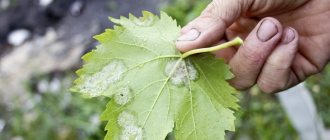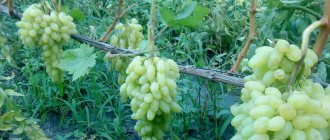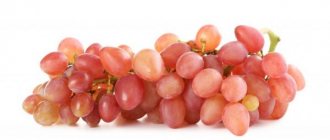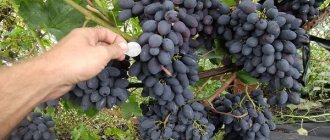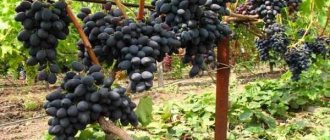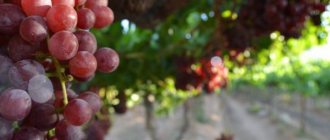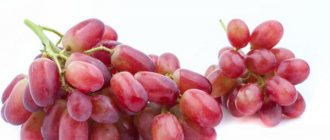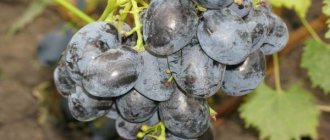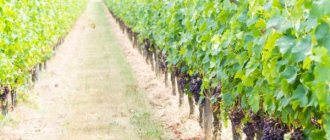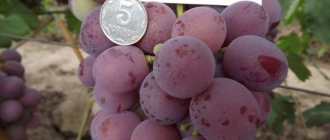History of variety selection
The Bogatyanovsky grape variety was bred by the famous amateur breeder V.N. Krainov from Novocherkassk, Rostov region. The grapes were included in the State Register of Russia in 2015. However, it appeared and became widespread much earlier. V. Krainov created the first hybrid forms in 1998, and after 11 years there were already 45 of them.
The hybrid variety is obtained by cross-pollination. The ancestors were “Kishmish radiant” and “Talisman”. The applicant and originator of Bogatyanovsky grapes is the All-Russian Research Institute of Viticulture and Winemaking named after. Potapenko, Novocherkassk. This crop is grown in the vineyards of Russia, Ukraine, Belarus, and Kazakhstan.
Pros and cons of the variety
When planning to grow grapes, it is recommended to first study the pros and cons of the hybrid variety. The list of positive characteristics of the variety includes:
- stable yield;
- balance of sugar content and acidity;
- good survival rate of cuttings;
- complete ripening of shoots;
- resistance to temperature changes and frost.
The disadvantages of Bogatyanovsky grapes are: average resistance to diseases and pulp with a slightly runny structure. Also a negative characteristic is the need to standardize yields.
Description of the Bogatyanovsky grape variety
The Bogatyanovsky variety belongs to large-fruited table grapes. It belongs to vigorous crops, and it does not matter whether it grows on its own roots or on a grafted bush. Bogatyanovsky grapes have good compatibility with rootstocks. The shoots are distinguished by high growth and rooting vigor. Cuttings ripen without problems for more than 65% of the entire length.
The flower of the Bogatyanovsky grape variety is bisexual. The presence of this feature has a positive effect on the quality of pollination, since there is no need to plant other varieties nearby. Accordingly, the fruiting of the crop increases. The flowering period occurs in mid-June.
Medium sized foliage. The shape is round, the dissection is weak or medium, 3-5 lobes. Surface without obvious tubercles. The color of the leaves is pale green. The leaf blade is serrated along the edges. Open petiole notch.
Conical or round brushes. Density is average. Large size 0.9-1.5 kg, can reach 2.5 kg. The fruits are oval-round in shape. The weight of the berry is 12-18g, with a diameter of 4 cm. After full ripening, Bogatyanovsky grapes acquire a yellow-golden hue with a brown tan. The amount of sugars is 17-22%; acidity indicator – 7-8 g/l.
The pulp is juicy, fleshy, not crunchy. The skin is dense. The taste is harmonious. There are 1-3 seeds per berry.
Attention! The external features of the Bogatyanovsky grape berry can be seen in the photo.
Features of the structure and ripening of bunches:
The hybrid "Bogatyanovsky" has large berries and large clusters. This is the largest of the Krainova varieties!
The clusters are large, cone-shaped with wings, average weight 1.0-2.5 kilograms, reaching a length of 35 centimeters. The density of the clusters is moderate, the berries do not get crushed in them and grow without deformation.
The color of “Bogatyanovsky” is white with an amber tint and a “tan” in the sun. The berry is large, ellipsoidal in shape and contains a lot of sugars and acids. Sugar content in different years is 18-22%. Acidity 7-8g/l. The seeds are large, at the stage of ripeness - brown, moderately hard.
A distinctive feature of the berries of the Bogatyanovsky hybrid is the presence of voids near the seeds.
The taste of ripe berries is ordinary grape, without nutmeg, but sweet with a fruity aftertaste, which leaves a very pleasant feeling. The pulp is moderately juicy, jelly-like, well adhered to the dense skin.
The ripeness of these grapes is very interesting: berries that are sour today can amaze you with their sweet, harmonious taste the very next day. This variety does not have an intermediate ripeness stage.
The brushes remain on the bushes for 20-25 days. Overripe berries shrivel and turn into raisins.
Characteristics of the variety
A positive feature of the Bogatyanovsky grape variety is the extremely rare cracking of the fruit. Minor mechanical damage heals quickly and without visible consequences.
Drought resistance, frost resistance
This grape crop belongs to the cold-resistant category. Bogatyanovsky grapes can withstand temperatures down to -24°C. The variety can do without shelter only in the southern regions. Drought resistance is high.
Productivity and fruiting
The Bogatyanovsky grape variety belongs to the mid-early crops. The time for ripening of berries occurs 125-140 days after the buds swell. With a load of up to 45 buds per bush, the yield coefficient is 1.1-1.4. As a rule, up to three inflorescences are formed on the shoots.
The Bogatyanovsky variety can safely be classified as high-yielding, since the fruiting of the bush is on average 70-85%, and under favorable weather conditions and proper care this figure is set at 90%. As a result, the Bogatyanovsky grape variety has earned many positive reviews and is in demand among winegrowers.
Attention! One vine produces up to 15 kg of harvest.
Area of application of fruits
Bogatyanovsky grapes belong to table varieties. Used to produce white wine. However, despite this, the fruits are preferable fresh. The brushes are attractive with their appetizing appearance and pleasant taste.
The transportability of the berry crop is also encouraging. During long-term transportation, the berries do not wrinkle or fall off, which is an undoubted advantage of the Bogatyanovsky variety.
Resistance to diseases and pests
The Bogatyanovsky grape variety has an average level of immunity, so it cannot be left unattended. Characterized by stability:
- to mildew at 3.0 points;
- oidium – 3.5 points;
- is not affected by gray rot.
Attention! The berry crop practically does not suffer from attacks by wasps and other pests.
Advantages and disadvantages of the variety
You can determine the strengths and weaknesses of the Bogatyanovsky grape variety from the reviews of winegrowers.
Advantages:
- unpretentiousness when planting;
- high frost and drought resistance;
- complete ripening of shoots;
- optimal balance of acid and sugar in taste;
- no peas;
- transportability;
- easy compatibility with rootstocks;
- shoot-forming ability;
- marketable condition.
Disadvantages of Bogatyanovsky grapes:
- shelter for the winter;
- wateriness of the pulp;
- the need to remove excess ovaries;
- susceptibility to fungal diseases.
Transportation and marketability:
“Bogatyanovsky” has established itself as a highly commercial variety. It can be easily transported over long distances. During transportation, the berries do not crack and do not fall off the brush. The main thing is not to overexpose the variety on the bushes and organize transportation during the first week after the onset of ripeness and sweetness of the berries.
Large berries and large bunches attract buyers with their appearance, and everyone without exception likes the taste.
Summary table of characteristics of the hybrid form “Bogatyanovsky”:
| Variety | "Bogatyanovsky" |
| Frost resistance | Increased to -23-24′ C |
| Disease resistance | Average |
| Pea planting | almost not |
| Sugar content | Excellent 18-22% |
| Aroma | Regular with a pleasant fruity aftertaste |
| Raw materials for wine | No |
| Consumed raw | yes, table variety |
| Transportable properties | High level, can withstand long distance transportation |
| Craving for the earth | Fertile sandy soils |
| Productivity | High, 60-80 kilograms per bush |
| Color | white with an amber tint and a “tan” in the sun |
Rules for planting grapes
The Bogatyanovsky variety does not require unique planting methods. Classic techniques apply to it. In the future, it is necessary to monitor the condition of the seedling and how successfully the adaptation to the new location was completed.
Recommended timing
The optimal time for planting Bogatyanovsky grape seedlings is considered to be mid-spring. It is important to get there before the sap starts flowing. However, due to bad weather conditions, the procedure should be postponed. Then the planting material must be placed in a cold place so that the reserves of nutrients and moisture are not depleted.
In warm regions, planting the crop in the fall is possible. In this case, it is advisable to have a couple of weeks in reserve before the onset of cold weather, so that the seedling has time to acclimatize to the new place.
Attention! The recommended planting dates for Bogatyanovsky grapes depend on the climatic characteristics of the region.
Choosing a suitable location
The Bogatyanovsky grape is not an early variety. Therefore, for faster fruit ripening, it is necessary to plant bushes in sunny areas. It is preferable to choose slopes oriented to the southwest. A location on a hill will insure the plant from the negative effects of frost.
Due to the low resistance to fungal diseases, air circulation must be ensured. For this purpose, a distance of 2 m or more is arranged between neighboring grape bushes. The grape culture grows well in fertile, light soils.
Attention! For full development, Bogatyanovsky grapes will require about 3 square meters. m area.
Selection and preparation of planting material
Planting material for Bogatyanovsky grapes must always undergo strict selection, since the further survival and productivity of the crop depends on the quality of the seedlings. Young plants are selected, adhering to the following standards:
- presence of at least 3 kidneys;
- length over half a meter;
- in grafted seedlings - dense fusion of the rootstock and scion;
- no visible damage to the bark;
- healthy, strong roots.
Preparing seedlings for planting in the ground involves preventive pruning of the roots and above-ground parts. Then the root system is immersed in a container of water to recharge.
Advice! Before the procedure, Bogatyanovsky seedlings are placed in a clay mash.
Landing algorithm
- The dimensions of the planting hole directly depend on the soil. For clay and sandy soils, you should dig a hole 80x80 cm, for black soil - 50x50 cm.
- The hole should be oriented from north to south, so the Bogatyanovsky grapes will be illuminated by the sun all day long.
- For soil that does not absorb moisture well, you will need to place drainage at the bottom.
- The pit is filled 1/3 full with a nutrient mixture of humus, compost, dry grass, potassium sulfate 25 g, superphosphate 40 g.
- Sprinkle garden soil on top with a layer of 7-10 cm so that the root system does not come into contact with fertilizers.
- The Bogatyanovsky grape seedling is placed in the hole and the roots are carefully straightened. Deepen to the first branch on the trunk.
- Sprinkle with earth, without tamping.
- The final stage is watering. 20 liters of warm water are poured under each bush.
- In the same year, young shoots are tied to vertical supports, and the next season it is worth securing a strong trellis.
Attention! If descriptions and photos are not enough to perceive the information, then it is worth watching a video of planting the Bogatyanovsky grape variety.
Tips from experienced winegrowers
Bogatyanovsky grapes (and other varieties) are not an easy crop to grow, so the advice of those who have been dealing with this plant for a long time is very important. Winegrowers give the following advice to beginners:
- You can water grape seedlings using plastic bottles with the bottom cut off and dug into the ground.
- There is no need to rush into planting seedlings in permanent beds: in the first year you can keep them in buckets in the ground; in the fall they are put away in the basement.
- The grapes must be tied horizontally.
- Watering should be limited - seedlings need plenty in the first two years, as well as all grape plantings in the fall. The rest of the time, you should water a little so as not to provoke shedding of flowers and a delay in the ripening of fruits.
- The sprinkling method is undesirable for grapes, it causes diseases, so it is better to build pipes for irrigation and channels for drainage.
- There is no need to carry out all operations with shoots at the same time; there is no need to immediately remove growing points and pinch out stepsons. When breaking out the stepsons, leave 1-2 leaves. The embossing is carried out in August after the crown has straightened.
- Grape bushes must be pruned to prevent crushing of berries and overgrowth of greenery. Pruning begins in the third year. Autumn pruning is carried out after leaf fall, around the beginning of November. In spring it is better not to prune the plant - this weakens it.
- The grapes are covered for the winter, especially in the first two to three years. Spunbond and film are used for covering. Underlay with boards or spruce branches. Be sure to leave small gaps for ventilation. In spring, the shelter is gradually removed.
- When growing a plant, you should record all the dates of planting, ripening, pruning, etc. This will make it easier to analyze the information.
These valuable recommendations will help you grow excellent Bogatyanovsky grapes in your garden plot, the photo and description of which were presented above.
Aftercare for grapes
Further care for the Bogatyanovsky variety involves a set of agrotechnical measures.
Moistening is standard: you need to pour 50-60 liters of water per month under the fruit-bearing bush. The depth of soil wetting must be at least 80 cm, otherwise the roots will not receive life-giving moisture. When the berries are completely filled, stop watering. Otherwise, excess moisture will cause the fruit to become watery and the amount of sugar will decrease. Before wintering, a final watering should be done if the autumn was dry.
To obtain the desired harvest, Bogatyanovsky grapes need to be fed. In early spring, use nitrogen fertilizers, during flowering - complex mineral preparations, after harvesting, do not apply potassium and phosphorus fertilizers.
Be sure to maintain cleanliness around the grape crop. Remove weeds in a timely manner and carry out loosening, eliminating the dense earthen crust.
Grape pruning
Rationing of bunches and formation of Bogatyanovsky grape bush deserves special attention. Winegrowers are curious about how a plant will react to a particular number of shoots or bunches. In the case of Bogatyanovsky grapes, the general recommendations are as follows:
- there should be no more than 35 eyes on the bush;
- shoots – 22;
- 7-10 buds are left on the vine.
If you do not adhere to the requirements and allow overload, the result will be: a decrease in the quantity and deterioration in the quality of the harvest, the growth of the plant will slow down, the period of fruit ripening will become longer, and the bunches will be poorly stored.
Important! The essence of pruning grapes is to remove the tendrils and create vertical growth of shoots using a trellis or other supports.
Protecting crops from birds and insects
To protect the crop from rodents and for preventive purposes, a stone hill is built around the trunk up to 30 cm high. Regent is an effective chemical preparation against them. You need to spray the soil around the plant with a solution of this product. The birds are kept out by a rigid mesh barrier, in which they will not get entangled and will be able to fly away freely.
Preparing grapes for winter
Almost all grape varieties need shelter for the winter. The Bogatyanovsky variety is no exception. However, the type of protection depends on the climatic conditions of the region:
- if the winter is snowy and frosty, then it is enough to lay the vine on a bed of spruce branches, and the snow will serve as a shelter;
- little snow, frosty weather - cover the compactly folded Bogatyanovsky grape vine with straw, spruce branches, hay, burlap, and cover it with earth on top;
- frosts give way to thaws - make a shelter, as in the previous version, and build a roof on top of waterproof material.
What to do if spring frosts are expected after warming
Problems arise with the vineyard when unexpected spring frosts return. Most of the fruitful bud or already blossoming shoots may die. It is known that grape leaves turn black already at 0 degrees.
- To reduce the risk of death of awakening buds, you need to treat the vine with 300 grams of iron sulfate diluted in a bucket of water. Water the vine well on all sides with the resulting 3% solution. This measure inhibits bud break for up to 5-7 days.
- Simple cultivation of grapes on a high trellis works against late return frosts: the height of the first stretched wire is 90-100 centimeters above the ground. The secret of grape survival lies in the fact that the temperature difference in the ground layer and at altitude reaches +5 degrees for every 1.5 meters. This video clearly describes these advantages.
- Covering a vineyard with blossoming buds can be done with a special covering non-woven fabric. The canvas “Spandbond SUF-17” has proven itself well. This shelter protects the vineyard from short-term frosts down to -5-6 degrees. In order for the protection to work, it is necessary to water the ground under the vineyard well with water from the middle of the day on the eve of the expected frost. Then fasten the covering fabric directly to the trellis with clothespins and sprinkle its ends. You will get a “hut” over the vineyard. It will protect the opened buds and your harvest due to the greenhouse effect.
- Various smoke screens have also long been used (burning foliage, wet straw, grass, etc. in areas) and bombs (including sulfur), which are installed at the beginning and end of the rows, and if the rows are long, then at the distance of each 20-25 meters. However, smoking is ineffective at temperatures below -2, as well as in strong winds. Another disadvantage is that smoke bombs are quite expensive.
- In recent years, modern wine-growing farms have often begun to use fogging units, which very effectively protect the crop from frost down to -6 degrees. Finely dispersed water spraying and sprinkling has only one drawback: it cannot be stopped even for a short time while the temperature is below zero, since the water drops will immediately freeze and the plant will die.
Methods of propagation of grapes
To propagate the Bogatyanovsky grape variety, the vegetative method is used, since the cuttings have a rapid survival rate. In the fall they are cut, and with the arrival of winter they are buried in earth. Before this, it is necessary to scratch the lower part of the cutting, which will be in the ground, in order to form embryonic roots in the seedling. Planting is carried out with the onset of warm weather, around April.
The Bogatyanovsky variety feels better in a grafted culture. There is practically no difference between a self-rooted and grafted plant.
Care measures
Fruit shoots are tied to wire. Green branches are spaced evenly on the trellis. The sleeves are changed when the shoots do not grow. To form subsequent branches, shoots growing from the heads of bushes are taken.
Every spring, they dig up the soil from the bushes and remove the roots from the top. If the plant switches to surface roots, it may die in winter. In this case, the bush is formed anew.
Diseases and pests, control methods and prevention
The purpose of preventive spraying is to prevent possible diseases. Complex protection consists of 2 treatments with an interval of 14 days. An effective remedy in the fight against fungal and bacterial infections is 3% Bordeaux mixture. Fungicides that have proven themselves to be quite good: HOM, Arcerid, Topaz, Skor, Ridomil. It is advisable to change medications and perform each procedure with a different chemical.
Attention! Spraying of chemical components of Bogatyanovsky grapes is carried out in the spring, immediately after removing the cover.
Morbidity and preventive measures
The Bogatyanovsky grapes exhibit average resistance to major grape diseases. All treatments carried out on bushes of this variety are standard and are sufficient to avoid diseases. It is important that preventive measures include spraying the bushes and soil with a 3-5% solution of iron sulfate before covering the vineyard, as well as after opening it in the spring. Treatment with 3% Bordeaux mixture before flowering or the drug “Polychom” will protect against mildew and anthracnose. Fungicidal preparations are also sprayed for preventive purposes before and after flowering bushes, as well as after precipitation.
Preparations with sulfur against ticks and oidium are also used. But in their use, it must be taken into account that spraying must be carried out in dry, hot weather, since sulfur vapor has the desired effect.
| Diseases | Sustainability |
| Downy mildew (mildew) | High |
| Oidium | Moderate |
| Gray rot | Average |
| Philoxera | Average |
Reviews from summer residents
Domestic gardeners consider Bogatyanovsky grapes to be one of the best varieties today. The size of the berries of this hybrid leaves no one indifferent. Summer residents who grow this crop speak very well about its taste. Fragrant, tender, sweet pulp with sourness is liked by both adults and children. Many summer residents use the berries of this variety to make wine. Bogatyanovsky is also liked by those owners of country plots who grow grapes for sale. The impressive bunches of this hybrid are selling like crazy on the market.
Gardeners also have a good opinion regarding the unpretentiousness of this variety. Not only does it tolerate winter well, its buds also do not freeze during return frosts in the spring. Bogatyanovsky berries, among other things, are almost never damaged by wasps. Caring for vines is no different from caring for any other varieties. In general, Bogatyanovsky grapes have earned – and quite rightly – quite good reviews.
Industrially used for making juices and wine
Bogatyanovsky grape variety - photo, planting, care:
Step 1. Choose a south side, protected from the north and northeast. Provide sufficient lighting for planting. Plant seedlings and cuttings in the middle of spring, when the air warms up to 10-15 degrees.
Related article: Rasmi grape variety
Step 2. Provide vertical strong trellises for garter.
Step 3 . Prepare the planting hole 2 weeks before planting. Considering the growth of this variety, leave 300 cm between seedlings and 500 cm between rows. Planting can be planned near a wall or gazebo. When planting near a house, the distance should be at least 1 m from the wall. Make the pit in the shape of a cube with sides 0.8-1 m.
Step 4. Fill the hole in layers: crushed stone, humus, fertile soil. Mix the two layers well and add fertile soil. After the earth settles in the soil, install a support stake and plant grapes.
Step 5. Bury an asbestos pipe nearby to apply fertilizer to the root system. Compact the soil around it and water well with warm water. You can add a little potassium permanganate for disinfection
Step 1. To preserve moisture, the tree trunk circle is mulched with manure or pine waste;
Step 2. Do not allow the soil to dry out and carry out timely watering. Water young plantings especially abundantly. During the ripening period, make sure that there is no stagnation of water and excess moisture to avoid cracking of the berries.
Step 3. In the fall, sprinkle the crop with rotted manure; it will serve as a reliable shelter for the vine and root system, and in early spring it will serve as a good top dressing. You can use spruce branches that protect the vine from rodents
Step 1 . The plant needs normalization. The total load on the bush should not exceed 35 buds. 22 shoots are left. Each shoot has 7-10 fruit buds. Overload prolongs the ripening period of grapes, depletion of the bush and poor ripening of the vine, which leads to poor resistance to frost and diseases. Forming is carried out in spring and autumn, using the fan method.
Step 2. Form bushes for high trellises using the fan method, so the vine is well ventilated. In spring and summer, catarrh is carried out (cutting out dew roots that are prone to freezing). When pruning in autumn, leave 6-8 eyes on the shoot. In the spring, you should not prune unless absolutely necessary; the vine may bleed juice and die.
Step 3. For grapes, apply the first pruning to 2 shoots, where 2-3 buds are left for development. The vine produces a good harvest, but overloading and underloading can affect poor ripening of the vine and an increase in the ripening period of berries
Step 1. Regularly carry out abundant feeding. Fertilizer for the first feeding is prepared from a mixture of 30 g of superphosphate, 50 g of wood ash, 10 liters of water and 2 kg of cow manure. Autumn fertilizing is carried out after harvesting.
Step 2: Insufficient iron in the soil can lead to lime chlorosis. Before the buds open, apply nitrogen-containing fertilizers and double superphosphate. After harvesting, feed the grapes with potassium salt for wood growth
Step 1. For grafting, it is necessary to cut the trunk of a strong plant with a well-developed root system. For grafting, you can use any cuttings, even those with 2 buds. Treat the drill with potassium permanganate and drill holes in the stem. If the diameter of the plant allows, there can be 2 or more holes.
Step 2. Insert cuttings into the holes, making sure that the cambial layers coincide as much as possible. Cover the cuttings with moistened shavings and cover with polyethylene. This vaccination should be carried out in April.
Step 3. Water the rootstock and hill it up with obligatory loosening of the soil to enrich it with oxygen. Monitor the germination of the rootstock. If roots form around them, they should be removed
Step 1. You can prepare the Chubuki yourself. The cuttings are harvested in the autumn. From a healthy bush, cut cuttings 10-12 cm long with several eyes, making sure the cut is even. After cutting, place the cuttings in a solution of 3% copper sulfate for disinfection and dry on a towel. Then wrap it in film and put it in the refrigerator.
Step 2. Place the cut cuttings in water and wait for white roots to form. Plant the cuttings in a pot with nutritious humate, after dipping it in a growth stimulator.
Step 3. Plant the grown and well-rooted cuttings into the ground. Taking into account the growth rate of the plant, leave a distance of 300-400 cm between the bushes. After planting, water thoroughly. Each plant will require 2-3 buckets of water
Step 1 . The variety is resistant to temperatures dropping to -22 degrees without shelter. In areas with colder winters, good protection of the vines is necessary. Seedlings require preparation for winter and reliable shelter.
Step 2. After the leaves fall, the shoots are pruned to 8-10 buds and watered abundantly. Place a flooring made of boards or agrofibre under the branches. Form a bundle from the branches and tie it. Cover the branches with fallen leaves or tow on top. Wrap everything in covering material, leaving the ends open for ventilation. You can secure it with wire or put a few bricks on top. Cover everything with 30-50 cm of soil.
Step 3. In spring, free the vine from its shelter and tie it to supports
Step 1. Carry out preventive treatment against gray rot with fungicides Benlat, Penconazole or Topsin. The final treatment before putting the grapes away for the winter should be done with copper sulfate. Treat grapes 2 times before flowering and 1 time after;
Step 2. If a disease is detected on the shoots, it is necessary to thin out the branches. Remove infected shoots and fruits. Weed the ground around the bush. Be sure to remove fallen berries and leaves so that they do not cause the development of fungal diseases.
Step 3. To prevent various diseases, you should promptly apply fertilizer and treat the bushes with insecticides against pests
Reviews from gardeners say that Bogatyanovsky grapes have the ability to regenerate, which has a positive effect on growing the variety in risky farming zones.
Related article: Exocarp
Where can I buy
As already mentioned, Bogatyanovsky belongs to the hybrids of folk selection. It was developed by V. N. Krainov, a well-known winegrower in our country. This gardener lives in the Novocherkassk region. The grape varieties he bred are sold mainly in specialized online stores. The cost of one cutting is estimated by summer residents as quite low. 800 rubles is the price that in most cases you will have to pay for a seedling of a garden plant such as Bogatyanovsky grapes. The description of the variety was given above. The excellent characteristics of this hybrid fully justify the cost of the cutting.
Features of care
The Bogatyanovsky grape variety is unpretentious, but requires regular agrotechnical measures:
- Pruning must be done every autumn, using a high-quality tool, since the cuts on the grapes do not heal, but dry out. Pruning begins from the top, simultaneously rationing the future harvest.
- Preventative treatment of the bush is carried out in the spring to prevent the appearance of bacterial and fungal diseases. For spraying, 3% Bordeaux mixture is most often used - purchased or home-made (a mixture of solutions of copper sulfate and freshly slaked lime ). Spraying is carried out in calm weather over the entire surface of the plant.
- Watering the plants is completed before mid-July to avoid cracking of the berries. During periods of severe drought, watering must be continued throughout the ripening period of the grapes.
Final advice:
- Obtain planting material only through specialized nurseries. Avoid random purchases or choosing a variety based on a photograph.
- For varietal diversity in a small area, you can graft the variety you like onto an existing rootstock. By the way, Bogatyanovsky is an excellent choice in this case.
- Grapes are a plant with a great will to live. So many times in the history of mankind it almost disappeared in wars and disasters, but was reborn again to the joy of people. Don’t let failures scare you: experience shows that it is possible to grow Bogatyanovsky grapes in the middle zone.
